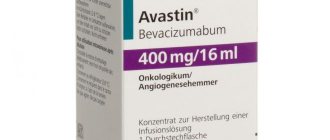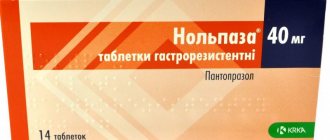Composition and release form
The dosage form of the drug is tablets that are elliptical in shape, white in color, with two notches on one side and a logo on the other. Available in 10 pcs. in a blister, 1, 3 or 10 blisters in a cardboard pack or 30 tablets in dark glass bottles.
The active element of the drug is methylprednisolone, auxiliary components:
- lactose;
- dried corn starch;
- calcium stearate;
- sucrose.
This is stated in the instructions for Medrol. Reviews of this medication are presented at the end of the article.
pharmachologic effect
Methylprednisolone is the active substance of the drug Medrol. This is a glucocorticosteroid (GCS). The substance penetrates cell membranes and forms complexes with cytoplasmic specific receptors. Subsequently, such complexes penetrate into the cell nucleus, where they form a bond with DNA (in particular, with chromatin), after which transcription of matrix ribonucleic acid is stimulated and the subsequent production of various enzymes occurs. This operating principle determines the effectiveness of GCS.
Methylprednisolone has an effect on the immune system and the course of the inflammatory process. In addition, this substance affects the processes of carbohydrate, protein and fat metabolism, skeletal muscles, the central nervous system and the cardiovascular system. Like other medications in this pharmacological category, methylprednisolone has antiallergic, anti-inflammatory and immunosuppressive properties.
Reviews from people taking Medrol are mostly positive.
The following therapeutic effects are achieved:
- suppression of phagocytosis;
- reduction in the number of immunoactive cells in the area of the inflammatory focus;
- decreased production of prostaglandins and compounds identical to them;
- stabilization of lysosome membranes;
- decreased vasodilation.
The intensity of the anti-inflammatory methylprednisolone and hydrocortisone is comparable. The first substance has only minor mineralocorticoid functionality. The catabolic effect on proteins manifests itself in the form of conversion of amino acids released during gluconeogenesis in the liver into glucose and glycogen. At the same time, there is a decrease in glucose consumption by peripheral tissues, which can contribute to hyperglycemia and glycosuria, especially in patients with a risk of developing diabetes mellitus.
Pharmacokinetics
Absorption of methylprednisolone occurs mainly in the proximal part of the small intestine, where it is approximately 2 times greater than in the distal part.
The binding of methylprednisolone to proteins (albumin and transcortin) is approximately 40–90%.
https://www.youtube.com/watch?v=ytpolicyandsafetyen-GB
The metabolism of methylprednisolone occurs in the liver and is qualitatively similar to the metabolism of cortisol. The main metabolites are 20p-hydroxymethylprednisolone and 20p-hydroxy-6a-methylprednisone.
Excretion. Metabolites are excreted mainly in the urine in unbound form, as well as in the form of glucuronides and sulfates, which are formed mainly in the liver and partly in the kidneys. Methylprednisolone is a corticosteroid with an intermediate duration of action. Due to intracellular activity, there is a marked difference between the half-life of methylprednisolone from the blood plasma (approximately 3.3 hours) and the half-life from the body as a whole (approximately 12-36 hours). The pharmacotherapeutic effect persists even when the level of the drug in the blood is no longer determined.
Lipolytic action
The lipolytic effect of the substance manifests itself initially in the extremities. In addition, the element exhibits lipogenetic properties, which are pronounced in the head, chest and neck areas. Together, this causes a redistribution of fat deposits. The maximum activity of the component does not appear at the peak of the plasma level, but only after it. This means that the effect of the drug is due to the effect on the activity of enzyme compounds.
This is confirmed by the instructions for use. It is better to read reviews about Medrol in advance, before starting to take the drug.
Indications for use
The list of indications for use of the drug includes the following pathologies:
- aspiration pneumonitis;
- fulminant or disseminated pulmonary tuberculosis;
- berylliosis;
- symptomatic sarcoidosis;
- Loeffler's syndrome;
- complex therapy of tuberculous meningitis with the threat of subarachnoid block or with it;
- diseases of the central nervous system (used in the combined treatment of myasthenia gravis of various origins);
- endocrine diseases: congenital adrenal hyperplasia, secondary and primary adrenal insufficiency, chronic and subacute thyroiditis, hypercalcemia in oncological tumors;
- thrombocytopenic purpura, as well as secondary thrombocytopenia, hemolytic autoimmune anemia, congenital hypoplastic anemia, erythrocyte anemia;
- therapy of acute connective tissue pathologies in systemic dermatomyositis, rheumatic carditis, lupus, giant cell arteritis, polymyalgia rheumatica;
- skin pathologies: erythema multiforme, bullous dermatitis herpetiformis, pemphigus, exfoliative dermatitis, mycosis fungoides, seborrheic dermatitis, psoriasis;
- short-term additional therapy for pathologies of the musculoskeletal system, including rheumatic diseases: in acute forms or exacerbation of psoriatic arthritis, ankylosing spondylitis, rheumatoid arthritis, gouty arthritis, nonspecific tenosynovitis, post-traumatic osteoarthritis, synovitis in osteoarthritis, epicondylitis;
- treatment of severe conditions with year-round or seasonal allergic rhinitis, serum sickness, hypersensitivity reactions to medications, contact dermatitis, atopic dermatitis, bronchial asthma;
- severe inflammatory processes associated with eye diseases: chorioretinitis, keratitis, optic neuritis, iridocyclitis, iritis, allergic corneal ulcers, allergic conjunctivitis, sympathetic ophthalmia, choroiditis and posterior diffuse uveitis;
- palliative treatment for oncological pathologies: leukemia, lymphoma;
- when stimulating diuresis and in order to achieve remission of proteinuria in patients with nephrotic syndrome, against the background of lupus erythematosus;
- ulcerative colitis and regional enteritis;
- development of trichinosis with damage to the heart muscle or nervous system;
- with swelling of the brain due to the development of a tumor in it, exacerbation of the condition with multiple sclerosis.
According to reviews, Medrol is very effective.
Contraindications
The medicine is contraindicated in the following cases:
- during lactation;
- with high sensitivity to components.
With caution, tablets are prescribed to patients with esophagitis, gastritis, peptic ulcer, intestinal anastomosis, acute or latent peptic ulcer, ulcerative colitis, diverticulitis, diabetes mellitus, hyperlipidemia, osteoporosis, hypothyroidism, myasthenia gravis, acute psychosis, myocardial infarction, hyperthyroidism, arterial hypertension, insufficiency heart disease, impaired renal and liver function, open-angle glaucoma, herpes simplex, HIV infection, measles, chickenpox, strongyloidiasis.
According to people's reviews, Medrol is most often well tolerated by the body.
Instructions for use
The medicine is taken orally. The dosage regimen is prescribed by a doctor based on strict indications. The dose is selected individually, taking into account the patient's response to therapy. The following daily dosage is recommended: 4-48 mg at the first dose, then adjustments are made depending on the nature of the pathology and the patient’s condition.
Overdose
Medrol is prescribed exclusively for oral use. Initially, the daily dosage of the pharmaceutical varies from 4 to 48 mg. Higher doses are recommended for the treatment of excessive fluid accumulation in brain tissue and reach 200–900 mg per day. Multiple sclerosis is treated with doses of 200 mg per day.
For children, the dosage is determined based on the child’s weight and only by the attending physician.
For hypocorticism in children, Medrol is prescribed at 0.18 mg/kg per day or 3.33 mg/m2, dividing the dose by 3 times. In other cases, the medication is used according to the instructions for use at 0.42 - 1.67 mg/kg per day or 12.5 mg/m2 per day, dividing the dose into 3 doses. The required dosage is selected specifically for the individual patient, taking into account the existing disease and tolerability of the pharmaceutical drug.
After prolonged use of pharmaceuticals, discontinue the medication gradually. If a good therapeutic effect is obtained, the smallest dose of the drug is selected to provide support for the achieved therapeutic result.
https://www.youtube.com/watch?v=cosamomglavnom
Throughout the entire period of therapy, it is necessary to control the dosage. During the remission period or in the stage of exacerbation of the disease, during a stressful period, it is recommended to increase the dose of the medication for some time, depending on the patient’s condition.
There are no established signs of overdose. Long-term use of the drug sometimes leads to the formation of hypercortisolism syndrome and other symptoms that occur during treatment with glucocorticosteroids.
There is no special therapy; treatment is based on symptoms. The active ingredient is removed by hemodialysis.
We suggest you read: Which beer is less harmful, filtered or unfiltered?
Clinical syndrome of acute drug overdose
not described.
Reports of cases of acute toxicity following an overdose of GCS are extremely rare. There is no specific antidote. Frequent repeated use (daily or several times a week) for a long time can lead to the development of Cushing's syndrome and other complications characteristic of long-term GCS therapy. Treatment is symptomatic. Methylprednisolone is eliminated by dialysis.
In case of overdose, side effects may increase. As treatment, it is necessary to reduce the dose of the drug.
For multiple sclerosis
For multiple sclerosis, 200 mg of the substance is prescribed, for cerebral edema - 200-1000 mg, after organ transplantation - 7 mg per 1 kg of body weight, for adrenal insufficiency - 0.18 mg per 1 kg per day. The withdrawal of the medication after long-term use is carried out gradually. If the dynamics of therapy are positive, gradually reducing the dose, you should stop at the lowest maintenance dose, which will help maintain the clinical effect.
This is confirmed by reviews of people taking the drug Medrol for myasthenia gravis.
Analogs
Level 4 ATC code matches:
Prednisolone
Polcortolon
Dexamethasone
Cortef
Dexazone
Metipred
Cortisone
Flosteron
Depo-Medrol
Solu-Medrol
Diprospan
Kenalog
Analogues of the drug Medrol:
- Deltason
- Prednisolone
- Metipred
- Depo-Medrol
- Solu-Medrol
Alternative therapy technique
The use of this drug is indicated using the alternating therapy technique, when double the dosage is taken once every other day in the morning. This method of treatment allows, with long-term use, to achieve maximum effect and significantly reduce the side effects of the drug associated with delayed development in children, suppression of the adrenal pituitary system, and withdrawal syndrome.
Interaction
When used together with Cyclosporine, a mutual slowdown in metabolism is observed.
Ephedrine , Phenobarbital , Theophylline , phenytoin , Rifampicin - reduce the therapeutic effect of methylprednisolone.
Ketoconazole, oleandomycin , oral contraceptives - inhibit the metabolism of methylprednisolone.
Methylprednisolone increases the clearance of spirin A and modifies the effects of anticoagulants .
Medrol increases the risk of side effects of cardiac glycosides and Paracetamol .
Alcohol and non-steroidal anti-inflammatory drugs together with methylprednisolone can cause intestinal ulceration and bleeding.
The simultaneous use of antacids reduces the absorption of methylprednisolone.
Medrol reduces the effectiveness of vaccines.
The drug enhances the metabolism of mexiletine and isoniazid .
Side effects
According to reviews of people taking the drug, Medrol can cause the following adverse reactions:
- Digestive system: peptic ulcer, gastric bleeding, esophagitis, pancreatitis, intestinal perforation, increased functions of alanine aminotransferase, alkaline phosphatase and aspartate aminotransferase.
- Metabolism: heart failure, sodium retention, increased blood pressure, hypokalemic alkalosis, potassium loss, fluid retention.
- Endocrine system: Cushing's syndrome, decreased tolerance to carbohydrates, hirsutism, development of latent diabetes mellitus, menstrual irregularities, slow development and growth. According to reviews of Medrol, side effects of this nature do not occur very often.
- Musculoskeletal system: steroid myopathy, muscle weakness, osteoporosis, tendon rupture, compression and pathological fractures, in tubular bones - avascular necrosis.
- CNS: increased intracranial pressure, pseudotumor in the brain, mental disorders, seizures.
- Visual organs: high intraocular pressure with the possibility of damage to the optic nerve, subcapsular posterior cataract, exophthalmos.
- Dermatological phenomena: petechiae and ecchymosis, thinning of the skin, delayed wound healing.
- Allergic reactions: hypersensitivity.
Reviews of people taking the drug "Medrol"
Patient reviews are varied. The clinical effect of treatment was positive in most cases, but there are a lot of negative reviews about the medicine. This is due to the fact that the drug often caused multiple adverse reactions from internal organs and body systems, which sometimes became the reason for its withdrawal.
What other reviews are there about the use of Medrol? Patients note that this is a rather serious medication, which is available only by prescription and is prescribed after a high-quality diagnosis. As for its effectiveness, patients note a good effect from the treatment, the elimination of many pathological symptoms with the development of severe forms of certain diseases. The medicine is used in the form of tablets that are easy to swallow, and the drug exhibits medicinal properties approximately an hour after administration.
We reviewed reviews of Medrol tablets and instructions for use of the drug.
special instructions
It is necessary to take into account the peculiarities of taking the drug.
Can I take it during pregnancy and lactation?
Pregnant women are given methylprednisolone only if safer drugs are ineffective. The use of Medrol during breastfeeding is contraindicated.
Use in childhood
The drug can negatively affect the growth and development of the body, so treatment of children is combined with constant monitoring of vital signs.
For impaired renal function
For pathologies of the excretory system, dose adjustment is not required.
For liver dysfunction
In case of severe liver diseases, the drug is used with caution.
Drinking alcohol does not affect the effect of methylprednisolone.
Alcohol compatibility
Drinking alcohol does not affect the effect of methylprednisolone.








